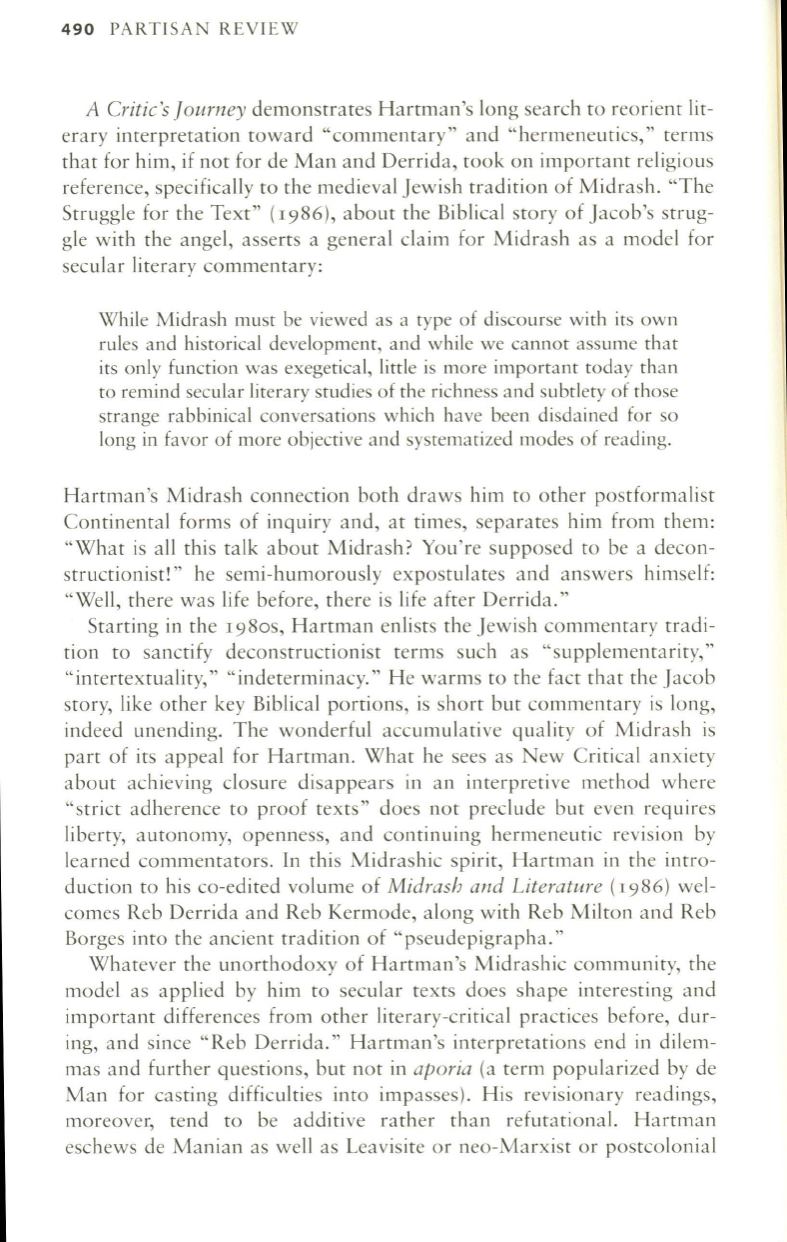
490
PARTISAN REVIEW
A Critic 's Journey
demonstrates Hartman's long search to reorient lit–
erary interpretation toward "commentary" and "hermeneutics," terms
that for him, if not for de Man and Derrida, took on important religious
reference, specifically to the medieval Jewish tradition of Midrash. "The
Struggle for the Text" (1986), about the Biblical story of Jacob's strug–
gle with the angel, asserts a general claim for Midrash as a model for
secular literary commentary:
While Midrash must be viewed as a type of discourse with its own
rules and historical development, and while we cannot assume that
its only function was exegetical, little is more important today than
to
remind secular literary studies of the richness and subtlety of those
strange rabbinical conversations which have been disdained for so
long in favor of more objective and systematized modes of reading.
Hartman's Midrash connection both draws him to other postformalist
Continental forms of inquiry and, at times, separates him from them:
"What is all this talk about Midrash? You're supposed to be a decon–
structionist!" he semi-humorous ly expostulates and answers himself:
"Well, there was life before, there is life after Derrida."
Starting in the 1980s, Hartman enlists the Jewish commentary tradi–
tion to sanctify deconstructionist terms such as "supplementarity,"
"intertextuality," "indeterminacy." He warms to the fact that the Jacob
story, like other key Biblical portions, is short but commentary is long,
indeed unending. The wonderful accumulative quality of Midrash is
part of its appeal for Hartman. What he sees as New Critical anxiety
about achieving closure disappears in an interpretive method where
"strict adherence to proof texts" does not preclude but even requires
liberty, autonomy, openness, and continuing hermeneutic revision by
learned commentators. In this Midrashic spirit, Hartman in the intro–
duction to his co-edited volume of
Midrash and Literature
(1986) wel–
comes Reb Derrida and Reb Kermode, along with Reb Milton and Reb
Borges into the ancient tradition of "pseudepigrapha."
Whatever the unorthodoxy of Hartman's Midrashic community, the
model as applied by him to secular texts does shape interesting and
important differences from other literary-critical practices before, dur–
ing, and since "Reb Derrida." Hartman's interpretations end in dilem–
mas and further questions, but not in
aporia
(a term popularized by de
Man for casting difficulties into impasses). His revisionary readings,
moreover, tend to be additive rather than refutational. Hartman
eschews de Manian as well as Leavisite or neo-Marxist or postcolonial


